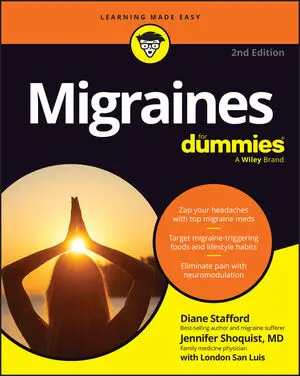Articles & Books From Migraines
Listen up and lock down today's best migraine pain solutions Haven't you spent enough time juggling schedules and cancelling events when headache pain sidelined you? You can put those days behind you with up-to-date information on the when-why-how of migraines and a whole-of-body approach to micromanaging them.
Cheat Sheet / Updated 09-15-2025
Today’s jam-packed migraine wheelhouse has treatments and lifestyle tips galore. Luckily, the right options will stop (or limit) your pain and nausea. Simply arm yourself with the latest knowledge on triggers to avoid, the medication that works for you, and a knack for moderating your sleep, exercise, hydration, meals, and stress.
Article / Updated 03-26-2016
As if migraines aren't big enough mischief-makers as it is, they also like to sing show tunes and take on different personas. So here we turn to migraine variants — the exceptions and odd lots that make finding your way to migraine diagnosis and treatment quite a challenging proposition. Abdominal migraines Abdominal migraines, which are sometimes diagnosed in children, are unusual because they cause pain in the stomach and lead to nausea and vomiting (sometimes without a headache).
Article / Updated 03-26-2016
So you go to see your doctor, and — oops! — you discover that she's just not "into" headache diagnosis. If you're not happy with her response to your concerns, shop around for another doctor. Find a doctor who'll agree to team up with you on a treatment plan. Some primary care doctors are old hands at treating headaches, while others may want to refer you to a headache specialist for diagnosis and treatment.
Article / Updated 03-26-2016
Several types of massage can be helpful in relieving the pain of migraine headaches. But there aren't enough studies to show how effective — or ineffective — these therapies are. Typically, migraine sufferers who benefit from massage use it as one component of their pain-relief plan, along with medications, lifestyle changes, and so on.
Article / Updated 03-26-2016
A rebound headache is a headache that you end up with just because you go in search of a little relief from the constant pounding in your noggin. You feel bad, so you take a pill — you feel worse, so you take another, and so on, and so on, and scoobie-doobie-do. Basically, you wind up with a headache because you're overusing medications.
Article / Updated 03-26-2016
If you're sick of dealing with migraines you need to develop a plan to prevent them. The steps to getting and staying as migraine-free as possible are: See your doctor for evaluation and treatment. Identify triggers and avoid them. Find medications that work and use them properly. Find a type of exercise that doesn't cause migraines for you and do it regularly.
Article / Updated 03-26-2016
Whether internal or external, anything that sets a migraine attack in motion is a trigger. Take a look at the following categories of common migraine instigators so you can track potential triggers for your headaches and steer clear of them in the future: Environment: Weather changes, high altitude, bright li
Article / Updated 03-26-2016
Whether you've been dealing with migraines for some time or you've never experienced one, make yourself aware of the symptoms that require medical attention. Severe headaches should not be taken lightly, if you experience any of the following symptoms, see a doctor as soon as possible: A headache accompanied by a stiff neck, fever, or rash.
Article / Updated 03-26-2016
Falling into the trap of migraine myths can prevent people from being diagnosed and treated properly. Migraines are valid problems. Migraine myths abound and some of the following are the more common misconceptions and the real story: Your doctor would have already told you if you actually had migraines. Not necessarily!



